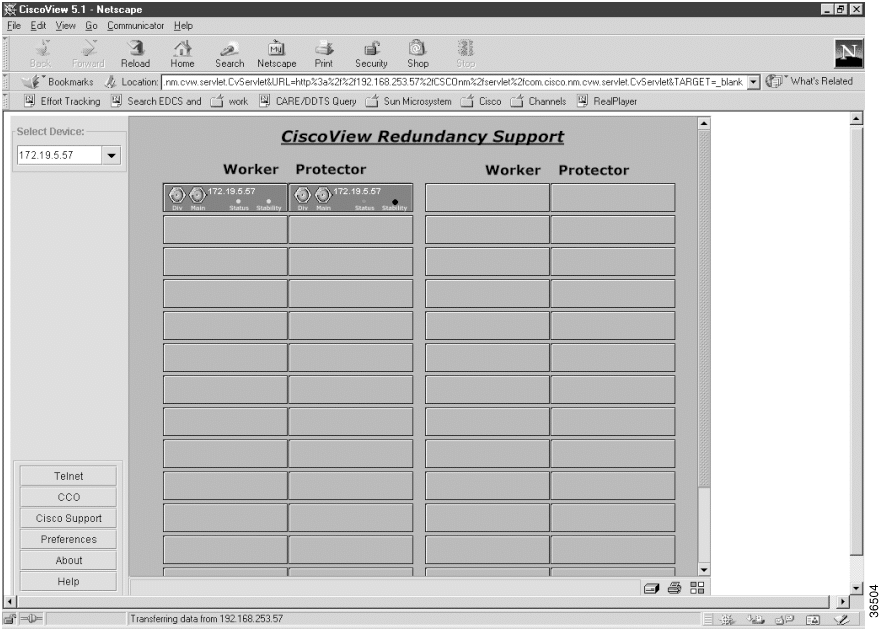|
|

For the CD One software to work correctly on Solaris 2.6 or 2.7, Solaris patches are required. Make sure that you have a browser, so that you can download the Solaris patches from http://www.sun.com.
The CD One software includes the device packages needed to manage the wireless aspects for the Cisco uBR7200 series and Cisco 26xx and 36xx series routers.
 |
Note If you install the CD One software, you do not need to install the device packages separately. |
If you need to reinstall the device packages for the Cisco uBR 7200 series and the Cisco 26xx and 36xx series routers, see the "Installing the Device Packages Independently" section .
You can use the Device Support Utility (DSU) to:
 |
Note Some device packages may have additional dependent packages. You must install these dependent packages before installing the device package. The DSU will report errors if the dependent packages are not already installed and are not selected. |
 |
Tips To run the command-line version of the device package, go to http://www.cisco.com/univercd/cc/td/doc/product/rtrmgmt/cw2000/cw2000_d |
During the installation, you can choose a third-party network management system (NMS) for integration. For further information on integrating the device package with a third-party NMS platform, refer to "Integrating with Third Party Vendors" at http://www.cisco.com/univercd/cc/td/doc/product/rtrmgmt/cw2000/cw2000_d/3steditn/use_view/xtocid104246
Step 2 To start the GUI-based DSU, enter ./xdsu.
Step 3 To install or uninstall the device packages, click Install or Uninstall.
See the online help for more instructions.
Step 2 Log in to the server with the default username: admin and password: admin.
Step 3 From the CiscoWorks2000 navigation tree, choose Device Manager>CiscoView.
Step 4 Enter the IP address of the device that you want to manage.
The GIF with the real-time status of the device appears.
 |
Note When you access a device for the first time, the community strings dialog box appears. Follow the default community string values of public for read-only and private for write-only. Change these values if the device is configured differently. |
Step 2 In the Preferences dialog box, change the parameters you want:
 |
Tips You can also change the label formats that appear in all tables and dialog boxes in CiscoView Wireless from the MIB variable name to a user-friendly name. |
In the client/server version of CiscoView Wireless, you can turn on debug and trace options from the CiscoWorks 2000 (CW2000) desktop.
Step 2 Choose Device Manager>Administration>CiscoView Server Admin>Setting debug options and display log.
Step 3 Select SNMP Activity or Activity Trace.
The SNMP requests are on the Java console and also logged to <CD One Install Dir>/www/classpath/cv.log on the server.
Step 4 Enter the following commands:
<CD One Install Dir>/objects/jrun/jsm-cw2000/logs/stderr.log
<CD One Install Dir>/objects/jrun/jsm-cw2000/logs/stdout.log
You can view managed devices in different views; with each device you can retrieve different kinds of information. For example, the front view shows the chassis and various network cards present, and the rear view shows the power-supply LEDs.
Each component is color coded.
| Color | Meaning |
|---|---|
Cyan | Dormant |
Ocher | Down |
Red | Fail |
Yellow | Minor alarm |
Pink | Testing |
Green | Up |
You can switch from one view to the other by choosing the corresponding viewing option from the chassis right-click menu.
With CiscoView Wireless, you can have a standby system that can take over in case the functional system fails in a wireless deployment.
Redundancy is defined as the ability to switch service from a Worker to a Protector with minimal disruption of service to customers.
 |
Note In order to guarantee the behavior and results of a redundancy, use a separate instance of CD One server and CiscoView Wireless client to monitor the redundant Worker-Protector network. |
With CiscoView Wireless, you can:
To retrieve a Worker-Protector, from the chassis right-click menu, select Worker-Protector Pair>View Worker-Protector Pair.
To create a new Worker-Protector pair, from the chassis right-click menu, choose Worker-Protector Pair>Add a new W-P pair.
The Redundancy view provides a logical representation of the configured Worker-Protector pairs and shows an array of GIFs, which represent a Worker-Protector pair and the status of various components.
Components represented for each Worker and Protector are:

To see the Redundancy View, select Redundancy from the chassis right-click menu.
You can retrieve different configuration parameters for each Worker-Protector.
![]()
![]()
![]()
![]()
![]()
![]()
![]()
![]()
Posted: Thu Mar 29 13:03:36 PST 2001
All contents are Copyright © 1992--2001 Cisco Systems, Inc. All rights reserved.
Important Notices and Privacy Statement.